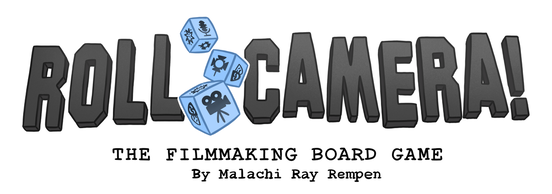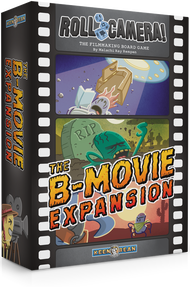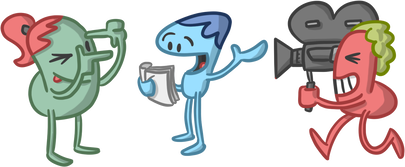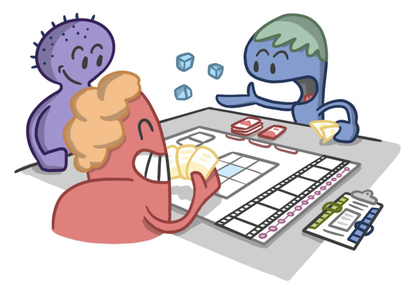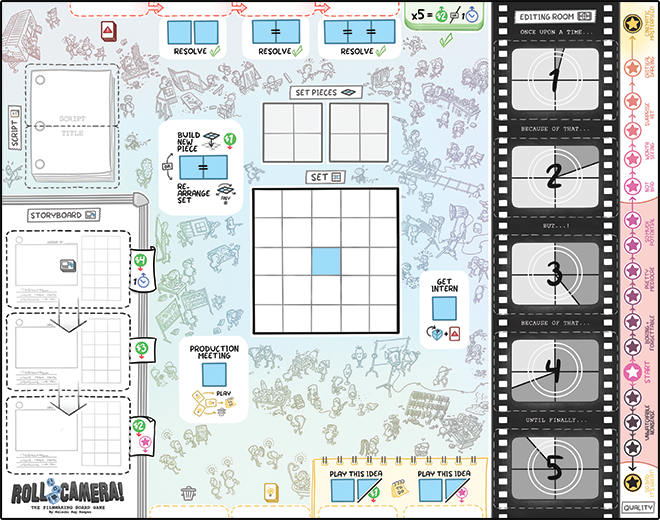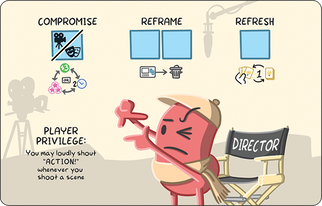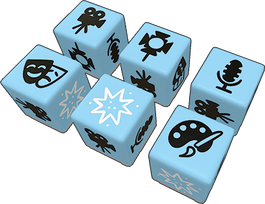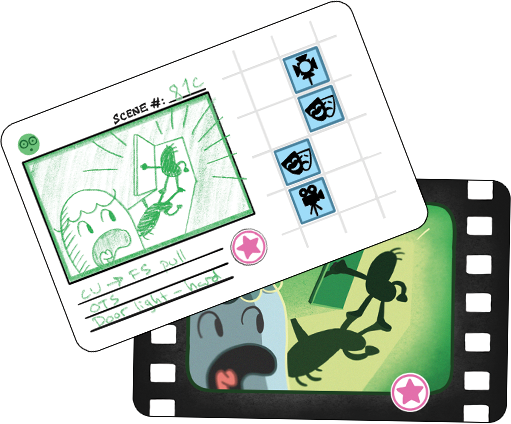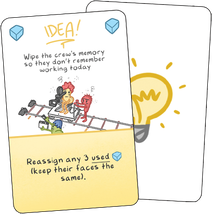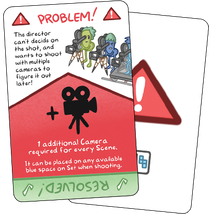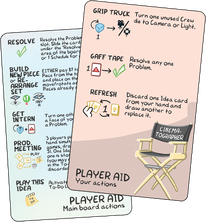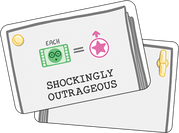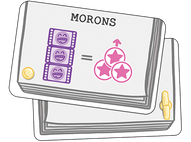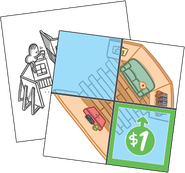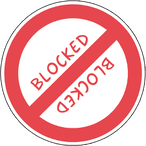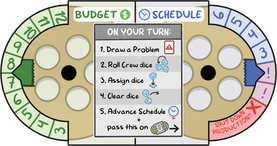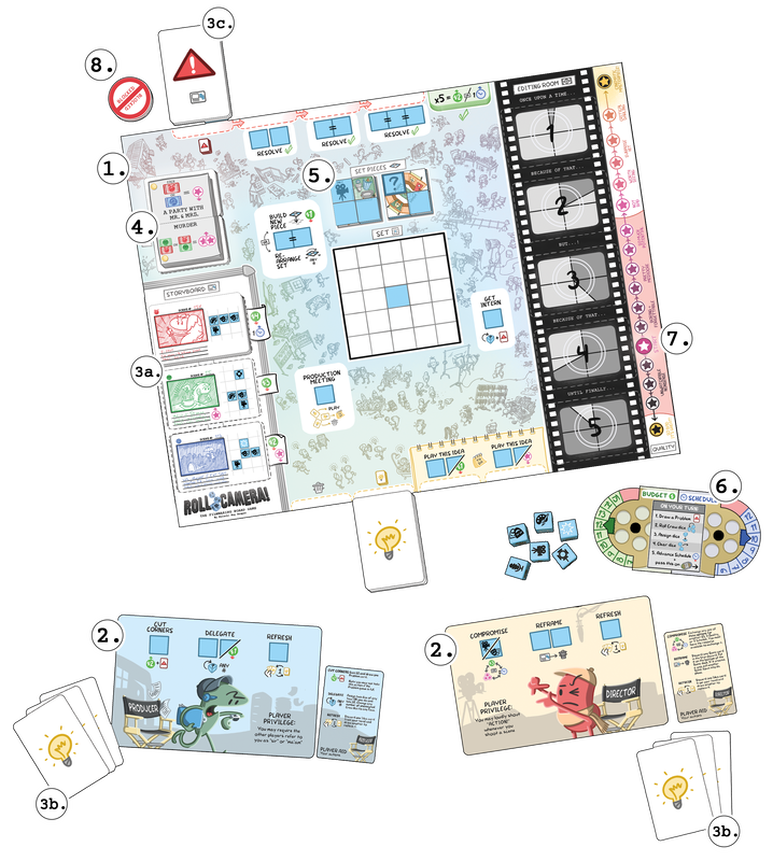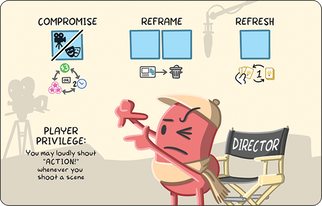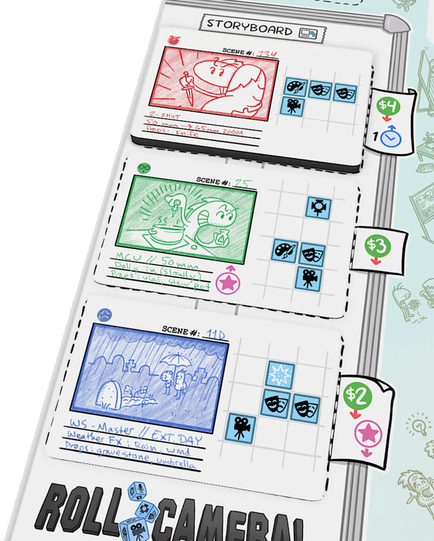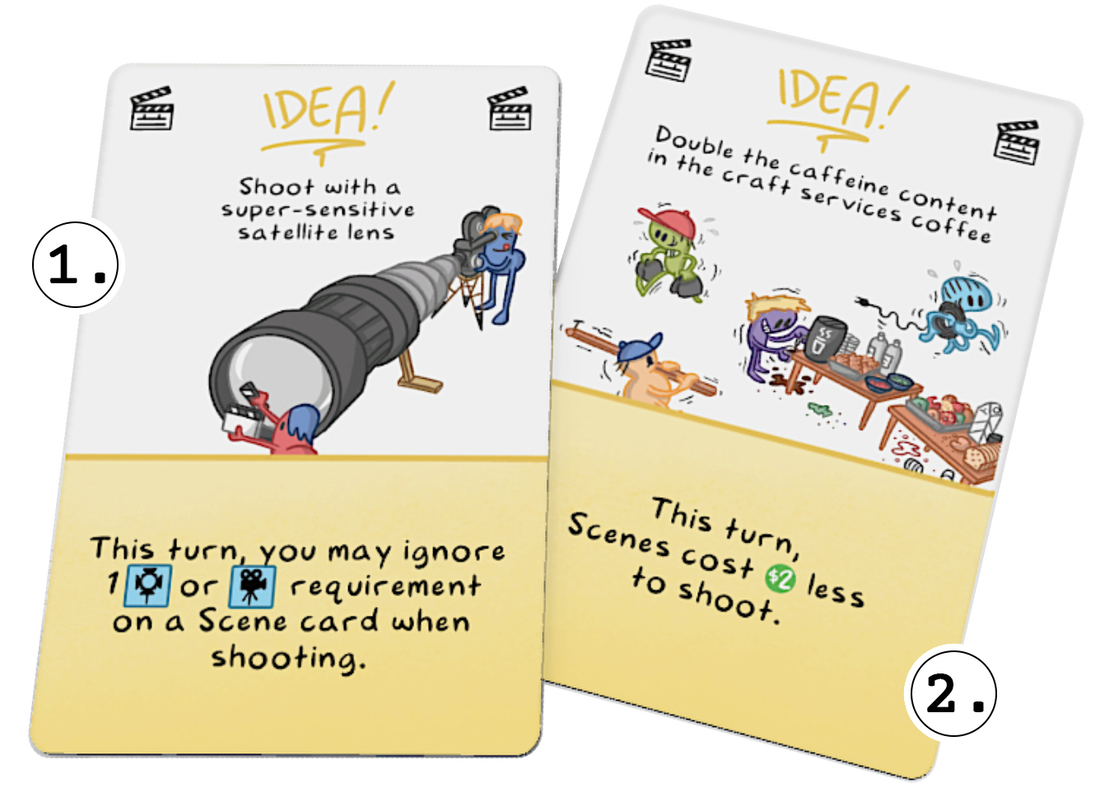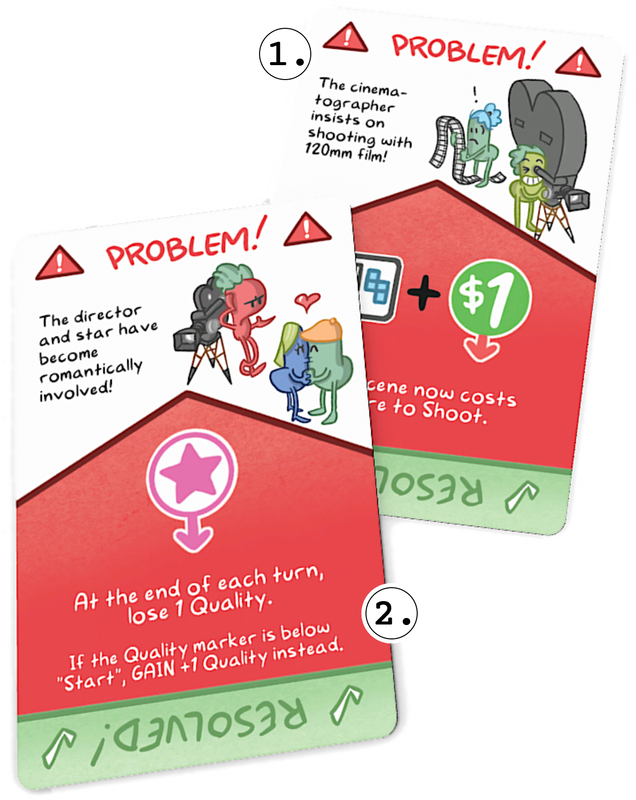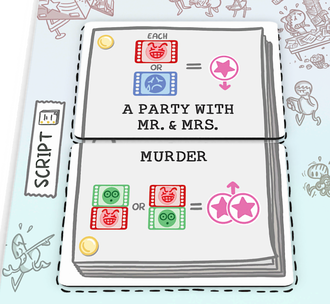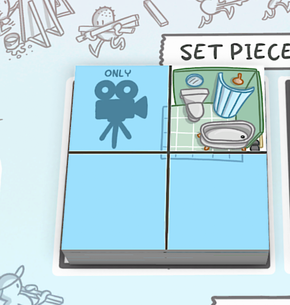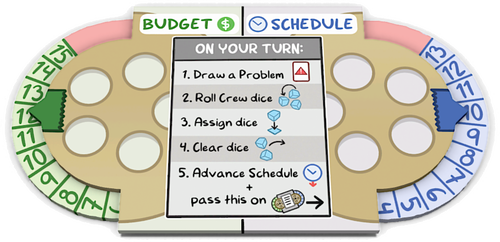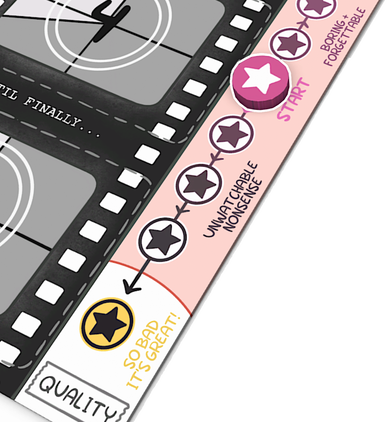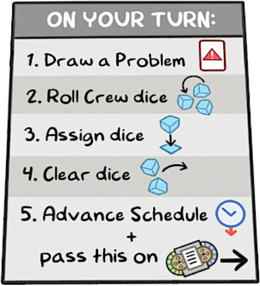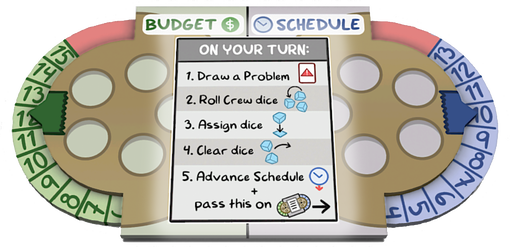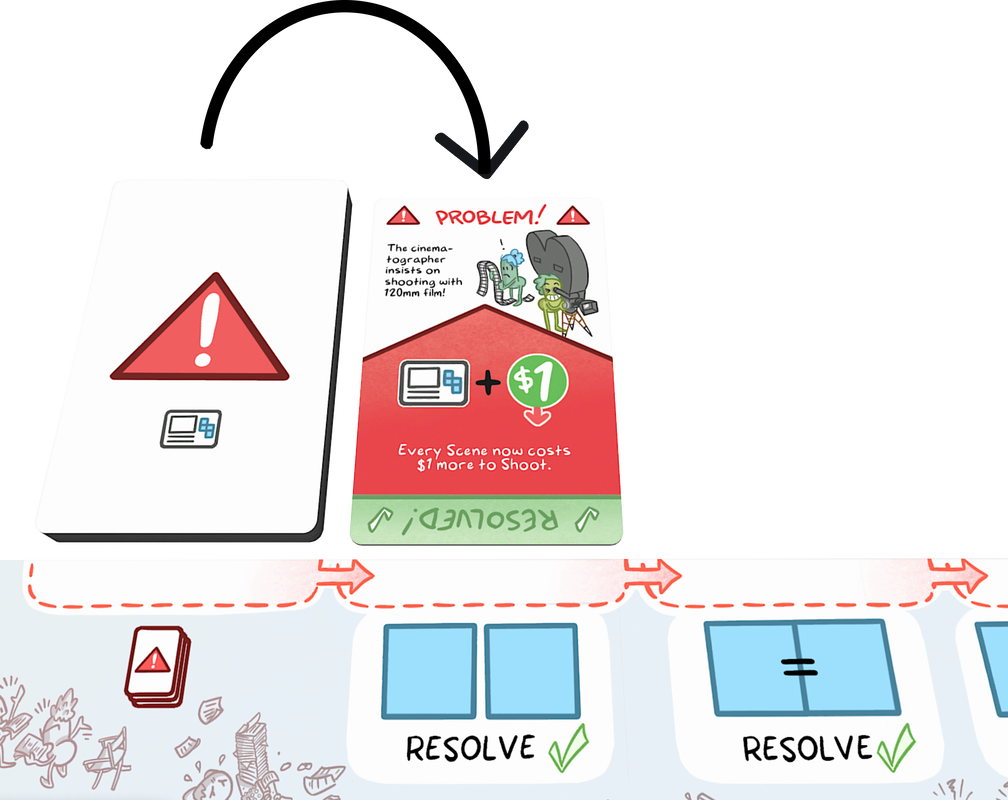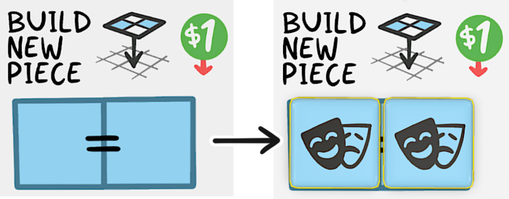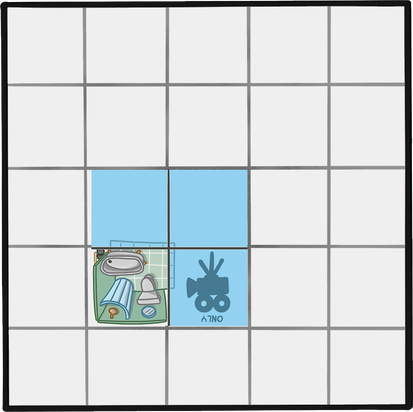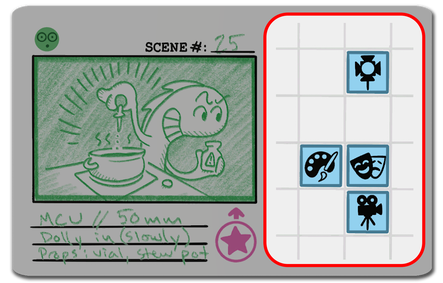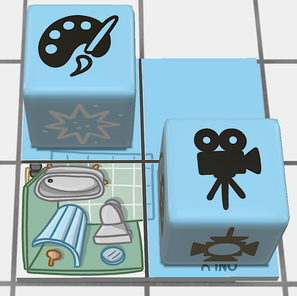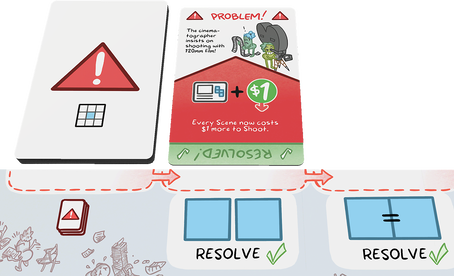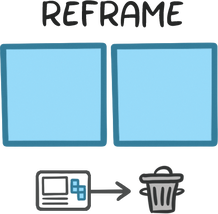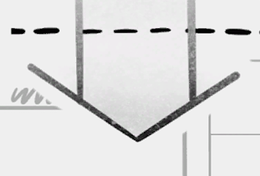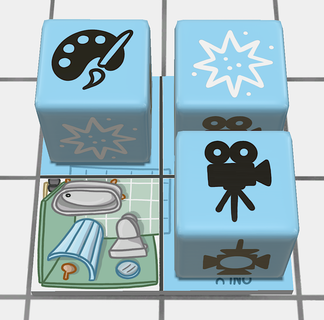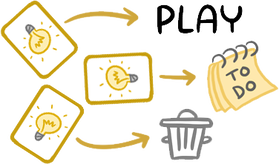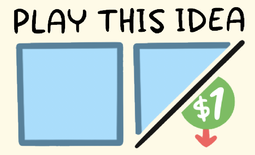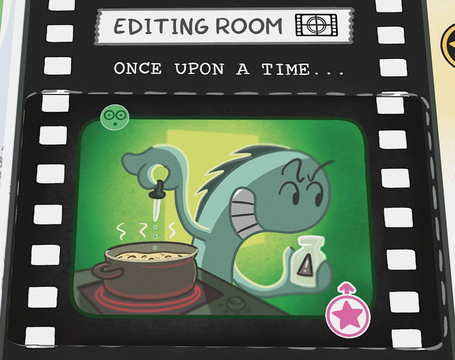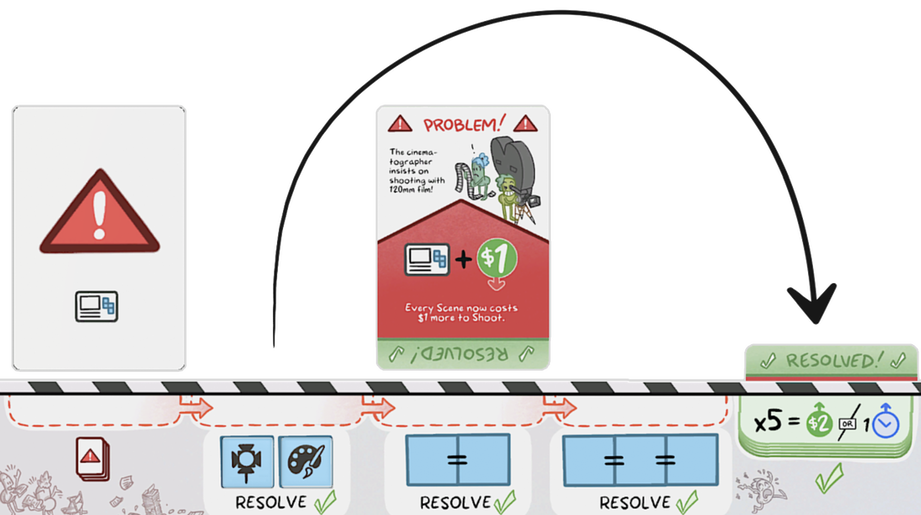NEWS: The Roll Camera! B-Movie Expansion is here!Shoot genre scenes like sci-fi, western, horror and crime! More roles! 100+ cards!
Put little hats on bean people!! |
Learn how to play...by playing!
If you prefer to learn by doing rather than reading the whole rulebook first, then Roll Camera! Film School is for you. Here we'll walk you through two sample turns, introducing you to the various parts of the game and the decisions you would be making along the way. Gather your friends (or play solo), open up the box, start reading aloud, and you'll be off!
By the end, you should have a good grasp of how to play. After the walkthrough you may continue playing or reset the game and start fresh. Either way, you may still need to refer to the rulebook later to understand some of the finer points. That's perfectly fine. Film School is not meant to be an exhaustive instruction, but rather a way to get you quickly up and shooting!
By the end, you should have a good grasp of how to play. After the walkthrough you may continue playing or reset the game and start fresh. Either way, you may still need to refer to the rulebook later to understand some of the finer points. That's perfectly fine. Film School is not meant to be an exhaustive instruction, but rather a way to get you quickly up and shooting!
Game overview
|
You work for a struggling film production company. This is your last chance to make a successful film; if you fail, the company goes bankrupt and you’ll never work in this town again! Produce this film on time and under budget, make sure it’s at least halfway decent, and make some sense of the resulting story. Do this, and your careers are saved!
Roll Camera! is a cooperative game; you will work together and win or lose as a team. Your goal is to produce the best film you can, on time and under budget. You'll roll your Crew dice and assign them to blue spaces, completing actions and shooting Scenes. You’ll need to be mindful of Problems that regularly appear, and be sure to follow your Script to manage the Quality of your film. But don't worry - you can collaborate through Production Meetings to generate new Ideas that can help put your unstable production back on track. The game ends as soon as you’ve Shot five Scenes. You win if at that point the Quality marker is outside the red zone; you lose if the Quality marker is inside the red zone. In addition, if at ANY time during the game the Budget OR Schedule dials reach the end of their tracks (noted by “SHUT DOWN PRODUCTION!!”), you lose immediately. There's no time to waste...Roll Camera! |
Components
|
1x Main game board, shared by all players.
|
6x Player boards (Director, Production Designer, The Star, Producer, Editor, Cinematographer), designating your role and your unique abilities.
|
6x Crew dice, each with 6 faces representing departments of your crew (Camera, Light, Sound, Actors, VFX and Art Department). On your turn you will roll and assign these dice to various actions, and to shoot Scenes.
|
|
25x Scene cards
The Scenes you will shoot. The front half has a setup diagram, the back half is the finished Scene for the Editing Room. |
40x Idea cards
Ideas are helpful cards which you keep hidden in your hand. To play them, you'll pitch them in a Production Meeting. |
35x Problem cards
Problems will get in your way and cause you trouble throughout the game. |
6x Player Aid cards
Player Aids are helpful double-sided reference cards. One side defines all the general actions on the game board, the other defines the specific actions on your player board. |
|
15x Script "top half" cards
The script is made of two halves. Each half gives you an end-game bonus or penalty on the film's Quality level. |
15x Script "bottom half" cards
|
12x Set Piece tiles
These represent the walls of the set you will build, on which you will shoot your scenes. |
3x "Blocked" tokens
Certain Problem cards will block off parts of the game from use. Use these to mark them. |
|
1x Quality token
To mark the Quality of your film. You must escape mediocrity to win. |
1x Budget / Schedule dials
To track your Budget and Schedule, very important resources. |
10x Production Company cards
Unique scenarios and variations to spice up the game for advanced players. You won't need them in your first game. |
Setup
|
In the game: Your player board gives you special actions that only you can take, on your turn. It also includes a "privilege" which doesn't affect the gameplay. It's just for fun.
In a normal game, you can choose any of the characters to play with. |
|
3a. Find the following three Scene cards and place them with the setup diagram “sketch” side up in the Storyboard slots in this order:
|
|
Then shuffle the remaining Scene cards and place them “sketch” side up underneath the top card (red “knife betrayal”).
3b. Find the Idea card “Shoot with a super-sensitive satellite lens” (1) and give it to the Director player. Find the Idea card “Double the caffeine content in the craft services coffee” (2) and give it to the Producer player. Shuffle the remaining Idea cards and place them face down in its space below the board (💡). Each player then draws random Idea cards from the top of the deck until they each have 3 total Ideas. (Remember: if you are playing solo you are actually playing as two players during this walkthrough, and each “player” should now have 3 Idea cards each). Keep your Ideas in your hand, hidden from other players. |
In the game: Idea cards give useful one-time bonuses or special ways to break the rules. You can only play Idea cards by holding a Production Meeting (more on that later).
|
|
3c. Find these Problem cards and set them aside:
Then shuffle together the remaining Problem cards and place the deck face down in its space above the board with the Problem deck symbol (top left). Place the set-aside Problem cards face down on top of the shuffled Problem deck so that (1) “The cinematographer…” is on top, and (2) "The director…” is immediately below it.
|
|
4. Scripts come in two halves - top and bottom, which combine to form your movie's script.
For this walkthrough, do the following:
Return any remaining script cards to the box. In a normal game, 5 random top script cards and 5 random bottom script cards are used. |
In the game: Script cards give you a Quality bonus or penalty at the end of the game. You can "rewrite" the Script in certain ways during the game.
|
|
5. Find the Set Piece tile pictured here (with 3 blue spaces including one "ONLY 🎥" space) and set it aside. Shuffle the remaining Set Pieces and place them face-up in two roughly equal stacks on their designated grey spaces on the main board, above the Set. Then take the set-aside piece and place it face-up on the shorter stack.
|
8. Place the Blocked tokens in a supply off to the side of the board.
On your turn
Now the game begins!
Hand the dials, the six Crew dice, and these instructions to the Director player. They will go first for this walkthrough.
Director: read the text that follows out loud and take the actions exactly as described. Just follow the directions - you don't have to make any decisions during the walkthrough! If you have questions, keep reading; they will likely be answered before the end. If you still have questions after Film School is over, the answers will be in the rulebook.
Director: read the text that follows out loud and take the actions exactly as described. Just follow the directions - you don't have to make any decisions during the walkthrough! If you have questions, keep reading; they will likely be answered before the end. If you still have questions after Film School is over, the answers will be in the rulebook.
First...I forget what to do on my turn! That's okay - I will look at the handy ON YOUR TURN sequence printed in the middle of the Budget / Schedule dials to remind me:
|
1. Draw a Problem
Ah yes! First I draw a Problem card from the deck. I put this card face-up in the first Problem queue slot directly to the right of the Problem card deck. I've drawn, "The cinematographer insists on shooting with 120mm film!" Shooting a Scene will now be $1 more expensive unless we resolve this Problem. Dang! |
2. Roll Crew dice
Next I would roll all six dice. The dice are our Crew, and on each of our turns we will assign them to various actions, and shoot Scenes with them by arranging them in the patterns on the Scene cards.
For the purposes of this walkthrough, let’s say I rolled the following, and I’ll set the dice faces to them now:
Next I would roll all six dice. The dice are our Crew, and on each of our turns we will assign them to various actions, and shoot Scenes with them by arranging them in the patterns on the Scene cards.
For the purposes of this walkthrough, let’s say I rolled the following, and I’ll set the dice faces to them now:
Now is as good a time as any to decide what Scene we want to work towards shooting. We can choose any of the three in the Storyboard. The top-half Script card ("A Party with Mr. and Mrs.") will penalize us with -1 Quality (⭐️) at the end of the game for having Blue or Red Scenes in our movie, but the bottom-half Script card ("Murder") will give us a bonus of +2 Quality for having Green and Red Scenes adjacent to each other.
Quality is tracked on the far right side of the board. If we want to win, at the end of the game that little pink disc (the Quality marker) must be outside the middle red zone - either "Not Bad" or better, or "So Bad It's Great."
So I suggest we aim to shoot the Green Scene in the middle of the Storyboard. You say you agree, Producer? Awesome.
|
3. Assign dice
Now I can assign the Crew dice I rolled to take various actions. In most cases, and for all of this walkthrough, each dice rolled can be used once per turn. We’ll need to build some Set Pieces out on the Set grid area to shoot with, so I’ll do that first. The Build New Piece action on the board requires two dice with the same face and costs $1 to take. I’ll use two Actor (🎭) dice by placing them together on the slot. I also need to pay $1, so I turn the Budget dial down from 12 to 11. Now we can choose one of the two Set Pieces to place on the Set grid. This central Set grid area is our empty film studio, and we are building the walls of sets we can use to shoot with. But we can only place our Crew dice on blue spaces when shooting Scenes. |
Any suggestions as to which Set Piece we should pick? What's that you say, Producer? Good idea! Let's take this one and place it like this:
We can cover up the blue square in the middle of the grid, which for this Scene won't help us. I'm so glad we worked together on this decision!
On the right side of the Green Scene card is the setup pattern we need to complete to shoot it:
On the right side of the Green Scene card is the setup pattern we need to complete to shoot it:
And I can already start setting up for it! I'll assign the Camera (🎥) die and one of the Art Department (🎨) dice to their respective spots on top of the Set Piece, like so:
To shoot a scene, we’ll first need our Crew dice in a pattern that matches the scene card. The pattern can be rotated or upside-down, but not mirror-flipped. The important thing is we can ONLY place dice on BLUE spaces.
Also, the word "ONLY" on this particular Set Piece means that only dice with the Camera face (🎥) can be assigned to that space, which is what I did; I'm a good board gamer and I follow the rules. Other Set Pieces have different restrictions or bonuses.
Also, the word "ONLY" on this particular Set Piece means that only dice with the Camera face (🎥) can be assigned to that space, which is what I did; I'm a good board gamer and I follow the rules. Other Set Pieces have different restrictions or bonuses.
|
Now I've got two dice left. I could use them to Resolve that Problem by assigning them to the slot beneath it, since it requires two dice of ANY face - they don't have to be the same. But I have a better idea.
|
Problems are resolved by assigning dice to the "Resolve" action slot beneath them. Each slot has a different requirement. You will do this next turn.
|
|
I assign the two remaining dice to the Reframe action on my Director player board. This allows me to discard one of the Scenes in the Storyboard and draw a new one.
Since the top half of the Script will penalize us for Blue Scenes, I'm going to discard the Blue Scene card in the bottom Storyboard slot. We wouldn't want to shoot it anyway. I remove the Blue Scene card and put it on the bottom of the Scene deck. |
Oh look! Removing the Blue Scene card has revealed a downward arrow. That means I pull the Green Scene card above it down to fill its place, and the Red Scene card on top of the Scene deck down to fill the middle space. There's now a new Scene in the top space available, and our Green Scene just became cheaper to shoot (moving from a cost of $3 down to $2). Not bad, eh?
4. Clear dice
My turn is over, so I gather up all the dice I used and hand them to you, Producer -- except the two dice I "locked in" on Set. I've started setting up that Scene, and you will hopefully finish it on your turn. The other dice have already been "used," so I clear them.
Yes, Producer, you will only have 4 Crew dice to roll on your turn, but we've already started the work of shooting together. It's called teamwork, ok?
5. Advance Schedule + pass the dials
Finally, I turn the Schedule dial down from 10 to 9. We always do this at the end of every turn. Then I hand the dials and the 4 available dice to you, Producer. It's now your turn.
My turn is over, so I gather up all the dice I used and hand them to you, Producer -- except the two dice I "locked in" on Set. I've started setting up that Scene, and you will hopefully finish it on your turn. The other dice have already been "used," so I clear them.
Yes, Producer, you will only have 4 Crew dice to roll on your turn, but we've already started the work of shooting together. It's called teamwork, ok?
5. Advance Schedule + pass the dials
Finally, I turn the Schedule dial down from 10 to 9. We always do this at the end of every turn. Then I hand the dials and the 4 available dice to you, Producer. It's now your turn.
1. Draw a Problem
First, I draw a Problem, as we always do at the start of every turn. But because you, Director, didn't resolve the Problem you drew at the start of your turn, it is still active. The old Problem must slide over one space to the right to make room, and the new Problem comes in the first slot. The old Problem has now become a bit harder to resolve, now requiring two dice of the same face instead of two of any face. And if we don't handle it this turn, it'll get even worse next turn! I'd say, "thanks for nothing," but this is a cooperative game so it's just as much my fault as yours. You're welcome.
First, I draw a Problem, as we always do at the start of every turn. But because you, Director, didn't resolve the Problem you drew at the start of your turn, it is still active. The old Problem must slide over one space to the right to make room, and the new Problem comes in the first slot. The old Problem has now become a bit harder to resolve, now requiring two dice of the same face instead of two of any face. And if we don't handle it this turn, it'll get even worse next turn! I'd say, "thanks for nothing," but this is a cooperative game so it's just as much my fault as yours. You're welcome.
Anyway, the Problem I've drawn is, "The director and star have become romantically involved!" Unless we resolve this Problem, we will now lose 1 Quality at the end of each turn, tracked on the far right hand side of the board. This movie production is going off the rails already!
Now it's time for me to roll the Crew dice. Hopefully I'll roll two doubles. That way we can build another Set Piece to complete the Scene AND we can resolve that Problem that's making our shoots more expensive.
2. Roll Crew dice
Again, for this walkthrough, let's say I rolled the following, and I’ll set the dice faces to them now:
Now it's time for me to roll the Crew dice. Hopefully I'll roll two doubles. That way we can build another Set Piece to complete the Scene AND we can resolve that Problem that's making our shoots more expensive.
2. Roll Crew dice
Again, for this walkthrough, let's say I rolled the following, and I’ll set the dice faces to them now:
Hmm. Not what quite what we wanted. But I think we can make it work.
3. Assign dice
Luckily, the 💥 face (VFX, or visual effects) is wild - we can use it on Set in place of any face needed for the Scene, or as the second half of a double when taking actions that require the same face. I will place it on Set like this, where the Actor (🎭) is meant to go:
We're using a clever visual effect instead of a real actor for this scene, like a face painted onto a broom or something. Movie magic, everyone!
But we can't shoot yet - according to the setup diagram on the Green Scene card, we still need a Light. I have a die with the Light face, but we can't place dice on white spaces, only blue, and I didn't roll the doubles needed to take the Build New Set action. What to do??
|
What's that, Director? You say you have an Idea that could help? Sounds good. We can't talk directly to each other about the Idea cards in our hands, so I'll have to call a Production Meeting to hear it. The Production Meeting is the only way to play Idea cards from our hands! We cannot play them by ourselves whenever we like. Filmmaking is a team effort.
So, I take the Production Meeting action on the main board by assigning a Camera (🎥) die there, even though any die would work. |
Why are Idea cards kept hidden? Don't we want to help each other?
Yes - but if all the Idea cards are available at the same time, one player can simply dictate what everyone will do. Hidden cards allows you to contribute better by dividing the work. Think of Idea cards as sitting in your head - you have to meet to get them out! |
In a Production Meeting, 3 Idea cards are pitched simultaneously face-up on the table, with a maximum of one card from each player. For this production meeting, I’ll pitch an Idea, the Director will pitch an Idea, and the last idea would come from a different player if this game had 3 or more players, but in 2 player games and for this walkthrough it will be a random card from the top of the Idea deck.
Ready? Okay, go!
I pitched “Double the caffeine content in the craft services coffee.” We could save $2 when shooting, which would be a good idea considering the “120mm film” Problem currently making our Scenes more expensive!
You, Director, have pitched “Shoot with a super-sensitive satellite lens.” This would allow us to shoot without a Camera or Light this turn.
The third Idea card pitched (drawn randomly from the deck in this 2-player walkthrough) is also an option.
Ready? Okay, go!
I pitched “Double the caffeine content in the craft services coffee.” We could save $2 when shooting, which would be a good idea considering the “120mm film” Problem currently making our Scenes more expensive!
You, Director, have pitched “Shoot with a super-sensitive satellite lens.” This would allow us to shoot without a Camera or Light this turn.
The third Idea card pitched (drawn randomly from the deck in this 2-player walkthrough) is also an option.
|
I’m not liking the random Idea card we drew from the deck. I will discard it, placing it face-up in the Idea discard space (🗑).
I want to save my Idea card (“double caffeine content”) for later, so I place it face-up in a slot under the To-Do List along the bottom of the board. Both slots are open, and I’ll choose the lefthand one. We can play this card later by taking the “Play This Idea” action space above it. Could come in handy! |
Your Idea, Director ("satellite lens"), is what we'll play immediately. I put that card in the Idea discard pile, and activate its effect now: we will be able to shoot the Green Scene and ignore the missing Light!
To end the Production meeting, each player that played an Idea card draws a new Idea card from the top of the Idea deck into their hand. Players should always have 3 Ideas in their hands.
Now let’s shoot that scene! Shooting a scene is a free action; if we meet a Scene card's requirements, we can shoot it any time during the turn. We have matched the pattern on our green Scene card (minus the Light which, thanks to your brilliant Idea, we don’t need). Next, we must pay the cost, which is listed on the Storyboard next to the Scene card’s slot:
To end the Production meeting, each player that played an Idea card draws a new Idea card from the top of the Idea deck into their hand. Players should always have 3 Ideas in their hands.
Now let’s shoot that scene! Shooting a scene is a free action; if we meet a Scene card's requirements, we can shoot it any time during the turn. We have matched the pattern on our green Scene card (minus the Light which, thanks to your brilliant Idea, we don’t need). Next, we must pay the cost, which is listed on the Storyboard next to the Scene card’s slot:
Normally we would pay $2 here, but the “120mm film” Problem is still active, so we have to pay an additional $1, for a total of $3. I turn the Budget dial to lower it from 11 to 8. We also lose 1 Quality, so I’ll move the Quality marker down one space on the Quality track.
We pick up the Scene and turn it over from the “sketch” side to the “finished celluloid” side, and put it in the topmost available Editing Room slot, which in this case is #1:
We pick up the Scene and turn it over from the “sketch” side to the “finished celluloid” side, and put it in the topmost available Editing Room slot, which in this case is #1:
Scenes in the Editing Room (like Scripts and the Storyboard) can be rearranged by Ideas, Problems, and certain player powers. But by default, finished Scenes are placed from top to bottom in the Editing Room.
Our shot scene shows a Quality star bonus on it, which means that is GAINS us 1 Quality when we shoot it! So I’ll move the Quality marker back up one space.
Now I’ll pull the two other unfinished Scenes in the Storyboard down to fill the empty spaces, revealing another new Scene in the top slot.
I still have two dice left! They are different faces, so I will use them to resolve the "romantically involved" Problem in the first, leftmost slot. I place the dice on the action space below the card. I remove the Problem from its slot, turn it upside-down, and slide it under the green RESOLVED! section of the board to the right:
Now I’ll pull the two other unfinished Scenes in the Storyboard down to fill the empty spaces, revealing another new Scene in the top slot.
I still have two dice left! They are different faces, so I will use them to resolve the "romantically involved" Problem in the first, leftmost slot. I place the dice on the action space below the card. I remove the Problem from its slot, turn it upside-down, and slide it under the green RESOLVED! section of the board to the right:
Now we won't lose 1 Quality at the end of the turn. Huzzah! And for every 5 Problems we resolve, we'll get to choose a bonus of either $2 or 1 Schedule. That'll be nice.
The middle Problem is still there, unresolved but still active, and it does not move backward. Problems only move forward, as indicated by the little red arrows on the board, and only if they are "pushed" forward by new incoming Problems. But we just cleared the leftmost space, so the next Problem drawn will fill that space and the existing one won't have to move yet.
4. Clear dice
It's the end of my turn, so I remove all the dice I used in my actions - which is all 6, since the dice on Set were used to shoot. I leave the Set Piece where it is. We can shoot on it again next time.
5. Advance Schedule + pass the dials
I turn the Schedule dial down from 9 to 8, and then hand the six dice and the dials over to the player on my left so they can take the next turn.
The middle Problem is still there, unresolved but still active, and it does not move backward. Problems only move forward, as indicated by the little red arrows on the board, and only if they are "pushed" forward by new incoming Problems. But we just cleared the leftmost space, so the next Problem drawn will fill that space and the existing one won't have to move yet.
4. Clear dice
It's the end of my turn, so I remove all the dice I used in my actions - which is all 6, since the dice on Set were used to shoot. I leave the Set Piece where it is. We can shoot on it again next time.
5. Advance Schedule + pass the dials
I turn the Schedule dial down from 9 to 8, and then hand the six dice and the dials over to the player on my left so they can take the next turn.
Now it's YOUR turn!
|
Congratulations! You've graduated Film School - these are all the main concepts and mechanisms in Roll Camera! You can now choose to either continue playing this game, or reset and start a new one. (NOTE: if continuing in a solo game, remove one of the player boards and its Player Aid card from the game and continue playing with the remaining role.)
You may have to refer to the rulebook a couple more times for further specific questions (on the back of the rulebook is a table of contents for quick reference). And don't forget the Player Aid cards that explain all the main board and player board actions. |
Hello, look at us! We're here to help
|
The game ends as soon as you’ve shot five Scenes. When that happens, finish the turn (including any Problem effects that trigger "at the end of this turn"), but don't advance the Schedule after the last turn. Then, refer to the Script cards to tally up your end game Quality bonuses or penalties.
You win if after that the Quality marker is outside the middle red zone (either "Not Bad" or above, or "So Bad It's Great" at the bottom); you lose if the Quality marker is inside that red zone at the game's end. In addition, if at ANY time during the game the Budget OR Schedule dials reach the end of their tracks (noted by “SHUT DOWN PRODUCTION!!”), you lose immediately.
Good luck!
You win if after that the Quality marker is outside the middle red zone (either "Not Bad" or above, or "So Bad It's Great" at the bottom); you lose if the Quality marker is inside that red zone at the game's end. In addition, if at ANY time during the game the Budget OR Schedule dials reach the end of their tracks (noted by “SHUT DOWN PRODUCTION!!”), you lose immediately.
Good luck!

